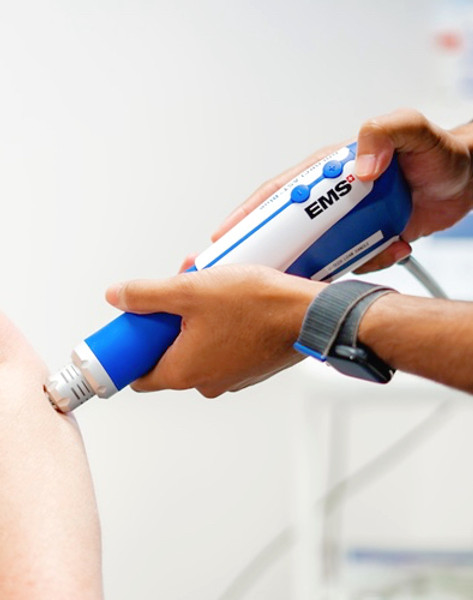
Tennis elbow
treatment
MOVEMENT MECHANICS OSTEOPATHY AUCKLAND
Treat lateral epicondylitis, also known as Tennis elbow, effectively with Shockwave Therapy.
Combining EMS Dolorclast® shockwave therapy with traditional osteopathic treatment for lateral epicondylitis has been shown to be superior to conventional physiotherapy alone. Shockwave treatment for tennis elbow is fast becoming the gold standard for conservative treatment of tennis elbow.

Fast
Treatments typically take 5 to 15 minutes, depending on the treatment site.

Non-invasive
A great alternative to steroid injections and surgery.

Effective
Reduces the average pain score from 8/10 to 2/10 within 4 weekly sessions.
What is Tennis elbow or lateral epicondylitis?
Tennis elbow is a tendinopathy of the common extensor origin at the lateral elbow, previously referred to as “lateral epicondylitis,” though it’s no longer considered inflammatory. The condition is now understood as a partially reversible, degenerative overuse-underuse tendinopathy, though “tennis elbow” remains the common term. Initial treatment should be conservative, including rest, osteopathy, physiotherapy, and nonsteroidal anti-inflammatory drugs. Eccentric exercises, similar to those used for chronic Achilles tendinopathy and plantar fasciopathy, are key in rehabilitation. For those who haven’t found relief with these methods, shockwave therapy combined with osteopathic treatment is an excellent option before considering surgery.


Osteopathy can effectively treat tennis elbow through a hands-on approach that reduces pain, improves joint mobility, corrects muscle imbalances, and promotes healing. Techniques such as myofascial release apply sustained pressure to trigger points to relieve tension and restore tissue mobility, improving pain and grip strength. Soft tissue mobilization enhances blood flow, reduces muscle tension, and promotes healing, while joint mobilization specifically targets the elbow to restore mobility and reduce stiffness. Osteopaths may also mobilize adjacent joints like the wrist, shoulder, and cervical spine to address underlying dysfunctions contributing to symptoms. Additionally, muscle energy techniques (MET) involve active muscle contraction and relaxation to improve mobility, balance muscles, and relieve pain, proving effective in treating tennis elbow.
Shockwave therapy is an excellent non-invasive treatment for tennis elbow (lateral epicondylitis), offering multiple benefits. It reduces pain by using radial shockwaves to stimulate sensory nerve fibres, interfering with pain signals and decreasing pain perception. Additionally, shockwave therapy promotes tissue healing and regeneration by increasing blood flow, encouraging neovascularisation (new blood vessel formation), releasing growth factors, and aiding in tendon healing and tissue remodelling. It also has anti-inflammatory effects, helping to modulate the inflammatory response and reduce swelling associated with tennis elbow.


The intensity of the shockwave therapy is very important for beneficial osteoarthritis patient outcomes. The higher the energy, the better the changes in both pain score and osteoarthritis index scores (WOMAC). With this in mind, it is important to remember that not all shockwave machines are created equal. The majority of leading literature showcasing the benefits of Shockwave therapy uses EMS DolorClast® Shockwave devices. These machines can sustain the same energy delivery at higher frequencies, demonstrating significant differences in energy output at higher frequency settings compared to other devices used in New Zealand, such as the Storz MASTERPULS® 200 ultra.
Tennis elbow, or lateral epicondylitis, is a painful injury of the elbow joint caused by repetitive stress (overuse). The pain is located on the outside (lateral side) of the elbow but may radiate down the back of your forearm. You’ll likely feel the pain when you straighten or fully extend your arm. Get treatment that works.
